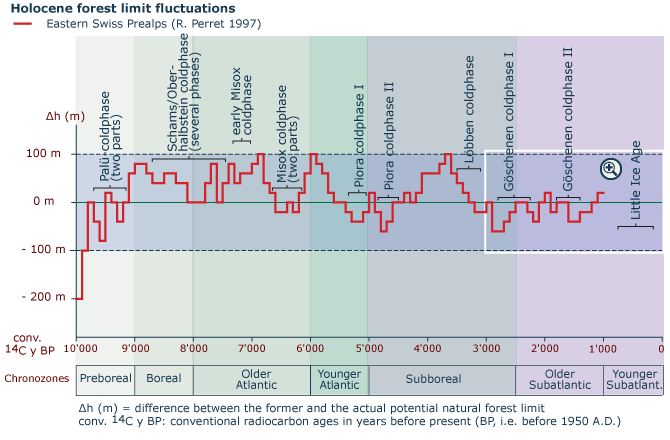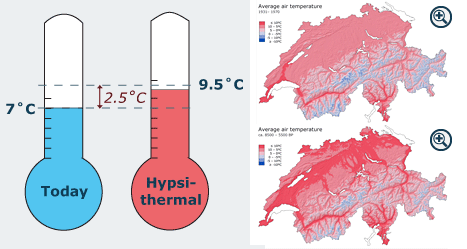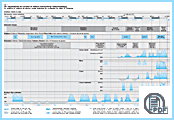 |
|
|
|
|
|
| Natural forest limit fluctuations give us information
about past climate changes. During the Holocene the natural forest limit
of the Eastern Alps and Prealps varied approximately +/- 100m compared
with its present position (fig. 1). These forest limit fluctuations are
caused by Holocene temperature variations of maximum +/-1°C. The
youngest cool period was the Little Ice Age (17th to 19th century). During
the Little Ice Age glaciers advanced in a number of regions mountain,
but the timing of maximum glacial advances differs, suggesting rather
that they may represent independent regional climate changes. |
1 - The Holocene forest limit oscillations due to climate fluctuations in the Eastern Swiss Prealps. The 0m-line shows the actual position of the potential natural forest limit (today’s forest limit without any human impact) at about 1900-2000m a.s.l. in the Prealps. Inset enlargement: Variations in length of Greater Aletsch glacier during the last 3200 years. The figures in meters on the right show the distance of glacier retreat compared with the glaciers length in 1850. Variations in glaciers length correlate with forest limit fluctuation (see e.g. Göschenen coldphase II) (after Burga & Perret 1998). |
| During the Holocene, shorter and longer phases occurred with temperatures as warm as today or even warmer and forest limits lying up to 100m higher its the actual natural position. Most Alpine glaciers were as small as today or even smaller during these warmer phases (fig. 2). The Hypsithermal (c. 8500 to 5500 years BP, Older and Younger Atlantic), is a well-known warm phase.
3 - Comparison of average air temperatures
in Switzerland today vs the Hypsithermal. (Maps from Burga & Perret 1998)
|
2 -Variation of glaciers' length as an indicator of Holocene climat oscillations. © Swiss Federal Office for Water and Geology (FOWG), 22 Nov. 2004 |
The Holocene is characterized by marked vegetation dynamic. Due to the milder Holocene climate, trees and herbs were able to leave their glacial refuges and immigrate into the Alps. E.g. : the components of mixed oak forest immigrated often in a certain order: elm, oak, lime/maple, ash. Scots pine, outlasting the Last Ice Age, still dominated
in the Swiss lowlands during the earlier Holocene (Preboreal). Today
Scots pine build forests on dry and poor soils of the colline and montane
belt. The beach, surviving the Last Ice Age in refuges in South and East
Europe, immigrated during the Hypsithermal. |
| Explore the diagram below and then answer the questions that follow. Clicking on the timeline will show vegetation maps for the timeperiod. The tree names link to images of the trees and further information. |
|
4 - Generalized pollen records of the Central European vegetation history since the Late Würmian |
29 August 2011 |
||
| |
||


